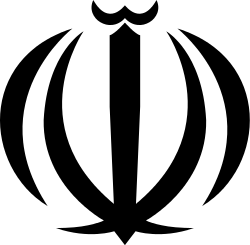Armenia–Iran relations
 |
|
Iran |
Armenia |
|---|---|
Armenia–Iran relations are the bilateral relations between Iran and Armenia.
Despite religious and ideological differences, relations between Armenia and the Islamic Republic of Iran remain cordial and both Armenia and Iran are strategic partners in the region.
The two neighbouring countries share to a great extent similar history and culture, and have had relations for thousands of years, starting with the Median Empire.
There are no border disputes between the two countries and the Christian Armenian minority in Iran, amongst the largest and oldest communities in the world,[1] enjoys official recognition. Of special importance is the cooperation in the field of energy security which lowers Armenia's dependence on Russia and can in the future also supply Iranian gas to Europe through Georgia and the Black Sea.
Stepan Safarian, of the Armenian Center for National and International Studies, has said "Given this geopolitical environment, Armenia has the legitimate right to cooperate with Iran for ensuring its security...Besides, Armenia has an energy surplus and its only major export market at present is Iran...So there is also a lot of economic interest involved."
Context
Iran and Armenia have been in close contact for thousands of years. Armenia was conquered by the Persian Empire several times throughout history, particularly in the Median, Achaemenid, Parthian, Sassanid, and Safavid, Afsharid, and Qajar periods. Due to the large cultural and historical ties, Armenia is sometimes considered part of Greater Iran. Armenia and Iran enjoy cultural and historical ties that go back thousands of years. Many Armenian dynasties were of Iranian origin, or are still under question of being so. Some of these are the Arsacid dynasty of Armenia (Branch of the Arsacids of Iran/Parthia), Orontid dynasty, amongst others. What is now modern day Armenia got only separated from Iran by the Russian victory in the Russo-Persian War (1804-1813) and Russo-Persian War (1826-1828). These losses made Iran irrevocably cede its Armenian territories, amongst its other regions of the Caucasus, to Imperial Russia as confirmed in the Treaty of Turkmenchay of 1828.[2]
Iranian-Armenians
The Armenian diaspora in Iran is one of the biggest and oldest Armenian communities in the world. It is also the largest Armenian diaspora in the Middle East. Although Armenians have a long history of interaction with Persia/Iran, Iran's Armenian community emerged when Shah Abbas relocated tens of thousands of Armenians from Nakhichevan to an area of Isfahan called New Julfa in the early 17th century, which was created to become an Armenian quarter. Iran quickly recognized the Armenians' dexterity in commerce. The community became active in the cultural and economic development of Iran.
The remaining Armenian minority in the Islamic Republic of Iran is still the largest Christian community in the country, ahead of the Assyrians.[3] The Armenians remain the most powerful religious minority in Iran. They are appointed two seats in Iranian Parliament (the most within the Religious minority branch) and are the only minority with official Observing Status in the Guardian and Expediency Discernment Councils. Today in Iran there are about 500,000 - 800,000 Armenians left, half of which live in the Tehran area. A quarter live in Isfahan, and the other quarter is concentrated in Northwestern Iran or Iranian Azerbaijan. The majority of Armenians live in the suburbs of Tehran, most notably Narmak, Majidiyeh, Nadershah, etc.
Trade
Of special importance is the cooperation in the field of energy security. In addition to a pipeline that will bring Iranian natural gas into Armenia.[4] Additionally, the two states have also implemented other multi-million dollar energy projects. These include the construction of two hydro-electric plants on the Arax River that marks the Armenian-Iranian border, a third high-voltage transmission line linking their power grids and dams, among other projects.
In July, 2007, a memorandum was signed on the start of feasibility studies on the ideas of building an Armenian-Iranian railway and a Russian-owned oil refinery that would process Iranian crude. In addition, the Armenian and Iranian governments have been working on a bilateral free trade agreement that could be signed by the end of 2007.[5]
The Armenian government is building a second, bigger highway leading to the Iranian border in the hope of boosting trade with Iran. In 2005, Armenia’s trade with Iran totalled a modest US$105 million. Trade volume between the two countries increased to US$200 million in 2009.[6] Trade relations continue to be strong.[7][8]
Former Iranian President Mahmoud Ahmadinejad has been quoted as saying "The Islamic Republic of Iran welcomes and supports the development of ties with Armenia in various areas, particularly in energy as well as transportation, sports, and tourism."
Cultural ties
Iran's cultural attaché to Armenia, Reza Atufi, has announced that the two countries have reached a preliminary agreement to make a joint television series. He said that the joint venture would portray the social and cultural life of Iran and Armenia and expand cinematic ties between the two countries.[9] There are also Iranian Armenians that maintain the language.
See also
- Persian Armenia
- Treaty of Turkmenchay
- Erivan khanate
References
- ↑ http://www.esisc.org/upload/publications/analyses/the-armenian-iran-relationship/Armenian-Iran%20relationship.pdf
- ↑ "Russia at War: From the Mongol Conquest to Afghanistan, Chechnya, and Beyond ...". Retrieved 23 April 2015.
- ↑ Golnaz Esfandiari (2004-12-23). "A Look At Iran's Christian Minority". Payvand.com. Retrieved 2012-03-21.
- ↑ http://www.regnum.ru/english/798463.html
- ↑ Danielyan, Emil (2007-10-19). "Iran's Ahmadinejad Due In Armenia". ArmeniaLiberty/Radio Free Europe. Retrieved 2008-01-19.
- ↑ http://www.presstv.ir/detail.aspx?id=117203§ionid=351020102
- ↑ http://www.reuters.com/article/2012/08/21/us-iran-sanctions-armenia-idUSBRE87K05420120821
- ↑ http://www.eurasianet.org/departments/insight/articles/eav072806.shtml
- ↑ http://www.presstv.ir/detail.aspx?id=21234§ionid=351020105
External links
| Wikimedia Commons has media related to Relations of Armenia and Iran. |
| ||||||||||||||||||||||||||||||||
| ||||||||||||||||||||||||||||||||||||||||||||||

